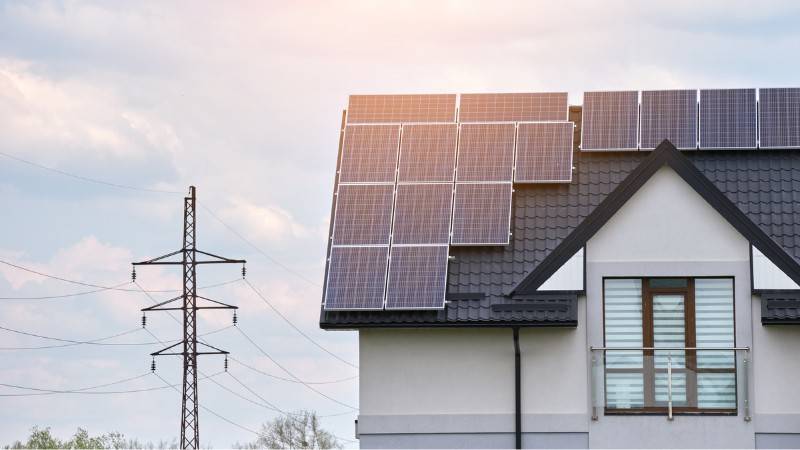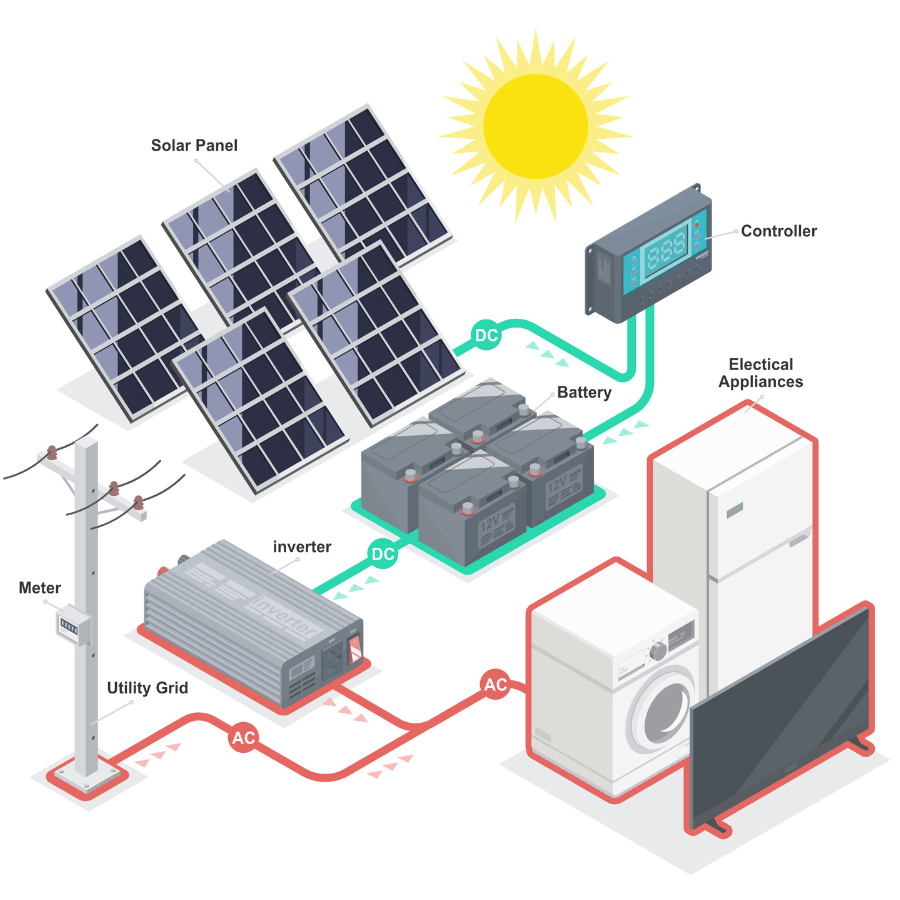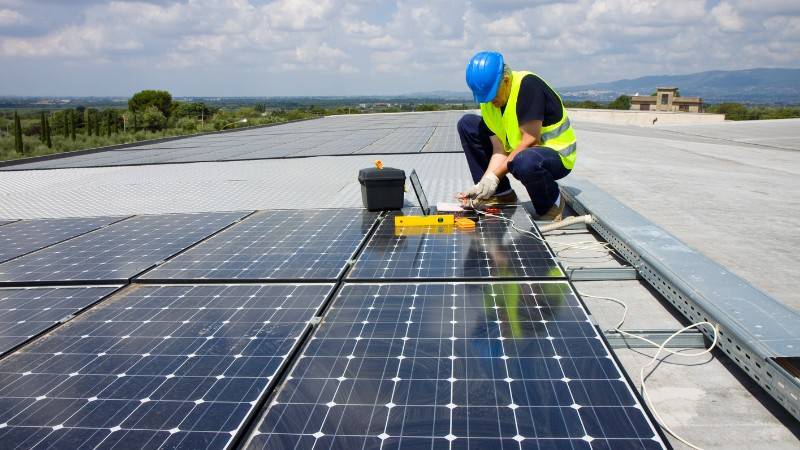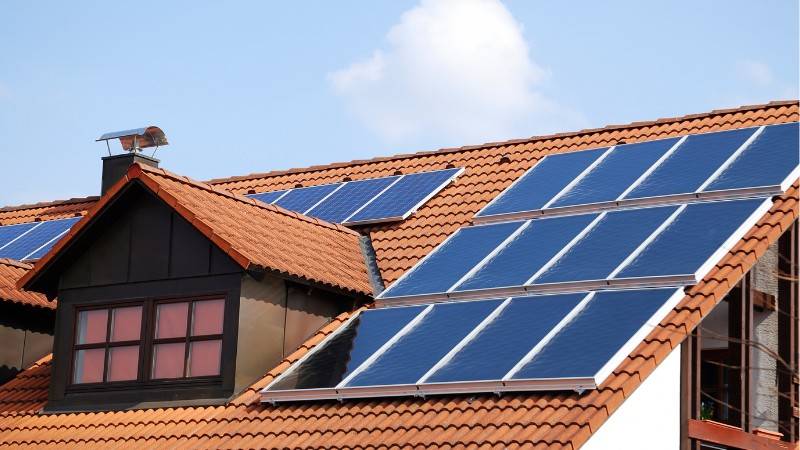Uncover the secrets of the sun! Learn how solar power works, its benefits, limitations, and financial incentives for investing in solar power in this guide.

Imagine a world where we harness the power of the sun to fuel our homes, businesses, and cars without harming the environment.
Sounds like a dream, right?
But this dream is not far-fetched. The rise of solar power as a clean, renewable energy source has made it possible.
In this journey, we’ll explore the fascinating world of solar power, taking you through the basics of how solar power works – from capturing sunlight to powering your home appliances.
Get ready to dive into the fundamentals of solar power, the photovoltaic effect, solar panels, grid connection, and more.
By the end of this voyage, you’ll have a better understanding of how does solar power work and how it can be a game-changer in our quest for a sustainable future.
Short Summary
Understanding the Photovoltaic Effect: The Magic of Solar Power
Solar power is a marvel of modern technology. At the heart of this renewable energy source lies the photovoltaic effect, which converts sunlight into electricity.
The photovoltaic effect occurs when sunlight strikes a solar cell, causing electrons to be released from semi-conductive materials such as silicon. These electrons are then directed by an electric field surrounding the wafer, producing an electrical current.
Traditional solar photovoltaic panels consist of various components, including silicon solar cells, metal frames, glass casings, and wiring. Each component plays a crucial role in harnessing the sun’s energy and transforming it into usable electricity.
As we dive deeper into the world of solar power, we’ll explore in detail how sunlight and electrons work together and the key components of a solar cell.
Electron Activity in Solar Cells
The relationship between sunlight and electrons is central to the functionality of solar panels. The intensity of sunlight directly impacts the light energy generated by solar panels. Usually, peak sun hours provides the highest concentration of sunlight for efficient electricity production.
But how exactly does sunlight initiate electron activity in solar cells?
When sunlight hits a solar cell, it induces electron activity, thereby creating an electrical current. This electrical current produced, is in the form of direct current (DC). This needs to be converted to alternating current (AC) electricity for use in homes and businesses.
Enter the solar inverter — a critical component that plays a pivotal role in converting the DC electricity generated by solar panels into AC electricity.
If you understand how the photovoltaic effect works, you'll understand how solar generators work seamlessly.
Key Components of a Solar Cell
Solar cells are the building blocks of solar panels, responsible for converting sunlight into electricity. A solar cell is composed of two types of semiconductors, namely p-type and n-type silicon, integrated into a p-n junction.
This composition is essential for making solar power work by converting sunlight into electricity.
Aside from silicon, a solar panel also consists of metal frames, glass casings, and wiring. Metal frames provide structural support, glass casings protect the cell from environmental factors. The wiring connects the cell to other components.
Each of these components works together to capture solar energy and transform it into electrical energy. Therefore, enabling solar panels to power our homes and businesses.
The Journey of Solar Energy: From Panels to Home Appliances
Harnessing the power of the sun, solar panels generate electricity through a multi-step process. It involves capturing solar energy, converting it into a usable form, and distributing it throughout our homes.
From solar panels on rooftops to the appliances we use daily, this journey of solar energy is a testament to the incredible potential of renewable energy sources.
In the following sections, we’ll delve into the specifics of how solar energy is captured, converted from DC to AC electricity, and distributed throughout the home.
By understanding this journey, we can maximize the benefits of solar power and minimize our reliance on fossil fuels.
Capturing Solar Energy with Solar Panels
Solar panels are the front line soldiers in the battle to capture solar energy. Utilizing the photovoltaic effect, they absorb sunlight and generate electrical energy.
To understand how solar panels work, it’s important to know that they consist of a series of photovoltaic cells connected together to form a module. This module is made from semiconductor materials such as silicon and arranged in a grid pattern.
The advantages of solar panels are numerous. They offer a clean, renewable energy source, lower electricity expenses, and help minimize greenhouse gas emissions.
In addition, solar panels can provide power to remote homes and businesses not connected to the electrical grid. This allows it to demonstrate versatility and potential for widespread adoption.
Converting DC Current to AC Current
Solar panels produce electricity in the form of DC, but homes and businesses require AC current. This is where the solar inverter comes into play. Inverters convert the DC electricity produced by solar panels into AC current for home use.
The distinction between DC and AC current lies in the direction and stability of the electrical flow. DC current is constant, and electricity flows in a single direction, whereas AC current has a cyclic flow direction.
By converting solar-generated DC current into AC current, inverters enable solar power to seamlessly integrate with our existing electrical systems.
Distributing Solar Electricity Throughout the Home
Once solar panels have generated electricity, the solar inverter has to convert it from DC to AC. After it's done, all we need is to distribute this power throughout the home. Electrical panels play a vital role in this process. These route solar-generated electricity to individual circuits and powers appliances and devices.
In cases where solar panels produce an energy surplus, the excess power is directed to the utility grid (for an on-grid solar generator). This not only ensures a continuous power supply for the home but also contributes to the overall efficiency and sustainability of our electrical infrastructure.
Harnessing Excess Energy With Solar Battery Storage
Solar power is a fantastic renewable energy source. But what happens when solar panels generate more electricity than a home needs at any given moment?
The answer lies in solar battery storage, which allows homeowners to store excess energy for later use, maximizing the benefits of solar power.
As we explore the world of solar battery storage, we’ll look at different types of solar batteries.
Types of Solar Batteries
Solar batteries come in various types, each with its own set of advantages and disadvantages. The most common types of solar batteries include lead-acid, lithium-ion, nickel-cadmium, and flow batteries.
Understanding the differences between these batteries is crucial when deciding on the best storage solution for your solar energy system.
On the other hand, Lead-acid batteries, have a relatively low depth of discharge and a shorter lifespan compared to other solar battery types.
Furthermore, lithium-ion batteries are favored for their improved efficiency and durability, though they come at a higher initial cost.
Flow batteries offer greater longevity and higher efficiency than lead-acid batteries, but also come with a higher price tag.
How Solar Batteries Work
Solar batteries are designed to store excess solar energy and provide a reliable source of power when needed. They achieve this by converting the DC electricity generated by solar panels into AC electricity that can be used to power homes and businesses.
This ensures that no valuable solar energy is wasted and that homes with solar panels can consistently maintain a steady power supply.
Solar batteries also play a critical role in maintaining the stability and efficiency of our electrical infrastructure.
By storing and releasing energy as needed, they help to balance the demands on the grid and promote the widespread adoption of renewable energy sources.
Enhancing Solar Panel Efficiency
Optimizing solar panel efficiency is essential to maximizing the benefits of solar power. Factors such as the type of solar panel, placement, and exposure to sunlight all play a role in determining the efficiency of a solar energy system.
By considering these factors and making informed decisions about solar panel selection and installation, homeowners can get the most out of their solar power systems.
In the following sections, we’ll explore the differences between monocrystalline and polycrystalline solar panels. We will also offer tips for overcoming challenges and optimizing solar panel performance.
With this knowledge, you can make informed decisions that lead to greater efficiency and cost savings.
Monocrystalline vs. Polycrystalline Solar Panels
When it comes to choosing solar panels, homeowners have two primary options: monocrystalline and polycrystalline solar panels.
Monocrystalline panels are more efficient but also more expensive, while polycrystalline panels are less efficient but come at a lower cost.
In terms of efficiency, monocrystalline panels generally have the highest ratings, ranging from 17% to 23%. Polycrystalline panels, on the other hand, have efficiency ratings between 7% and 11%.
Although monocrystalline panels are more expensive, their increased power production can make them a worthwhile investment for homeowners.
Optimizing Solar Panel Performance
Optimizing solar panel performance involves addressing a variety of challenges, including —
- Efficiency of solar cells,
- Weather conditions,
- Module damage,
- Dust and debris accumulation,
- Inverter failures,
- Solar panel degradation,
- Maintenance requirements,
- Limited space for utility-scale solar photovoltaics.
By taking steps to overcome these challenges, homeowners can ensure that their solar panels perform at their best.
Some measures to optimize solar panel performance include proper placement to maximize sunlight exposure.
You can also minimize shading by pruning trees and avoiding obstructions. Moreover, choosing the right components and accessories for the solar panel system can also help. You should also clean your solar panel from time to time to maximize its performance.
By addressing these challenges, homeowners can maximize the efficiency of their solar panels and enjoy the full benefits of solar power.
Grid Connection and Net Metering: Making the Most of Solar Power
For many homeowners, the decision to go solar comes with the added benefit of remaining connected to the local grid.
This grid connection, paired with a billing system is called net metering. It allows solar-powered homes to earn credits for excess solar energy production, reducing their overall electricity costs.
As we explore the world of grid connection and net metering, we’ll discuss the process of connecting solar power to the grid and the advantages it offers.
We’ll also dive into the concept of net metering and how it enables homeowners to earn credits for surplus solar energy production, ultimately saving money on their electricity bills.
Connecting to the Grid
Grid-tied solar systems provide homeowners with the best of both worlds: the ability to generate their own clean, renewable energy while remaining connected to the local grid for a reliable power supply.
Therefore, connecting solar power to the grid involves an inverter that transforms the DC power generated by solar panels into AC power compatible with the grid.
In addition, grid connection offers homeowners the opportunity to earn credits for the surplus electricity generated by their solar panels.
This system helps reduce electricity costs and contributes to the overall efficiency and sustainability of our electrical infrastructure.
Earning Credits Through Net Metering
Net metering is a billing mechanism that allows solar energy system owners to receive credits for the electricity they contribute to the grid.
This means that homeowners can sell their surplus solar-generated electricity back to the grid, reducing their overall electricity costs and making the most of their solar power investment.
In addition to its financial benefits, net metering plays a crucial role in promoting the widespread adoption of renewable energy sources. Net metering also helps to reduce our reliance on fossil fuels and pave the way for a cleaner, more sustainable future.
Summary
Solar power is an extraordinary renewable energy source with the potential to revolutionize the way we power our homes and businesses.
From the photovoltaic effect and solar panel efficiency to grid connection and net metering, we’ve explored the fascinating world of solar power and the many benefits it offers.
As we strive towards a more sustainable future, solar power serves as a shining example of how clean, renewable energy can transform our lives and help preserve our planet for generations to come.
With this knowledge in hand, let us harness the power of the sun and make the most of this incredible resource.
Frequently Asked Questions
Solar power powers your home by absorbing energy from the sunlight in solar panels and converting it into direct current (DC). This is then inverted to alternating current (AC) before being sent to your electrical panel, where it can be used to power lights and appliances. Excess solar electricity may also be sent to the grid.
Solar panels installed on your roof or property can still generate electricity during a power outage, thanks to solar energy absorbed through sunlight.
Solar battery storage is becoming more popular and is an important way for utility companies to incorporate more renewable energy into their infrastructure.
The photovoltaic effect is the process by which solar panels convert sunlight into electricity, utilizing the release of electrons from semi-conductive materials when exposed to sunlight.
The most common types of solar batteries are lead-acid, lithium-ion, nickel-cadmium, and flow batteries.
To optimize the efficiency of your solar panels, consider factors such as type, placement, and exposure to sunlight. Minimizing shading and selecting the right components and accessories can also help enhance performance.














The comprehensive nature of this guide is truly commendable, as it covers all aspects of solar energy, from the environmental benefits to the potential drawbacks. I particularly appreciated the real-world examples and case studies that illustrate the practical applications of solar energy. It’s evident that the author has done their research and is passionate about promoting sustainable energy solutions.